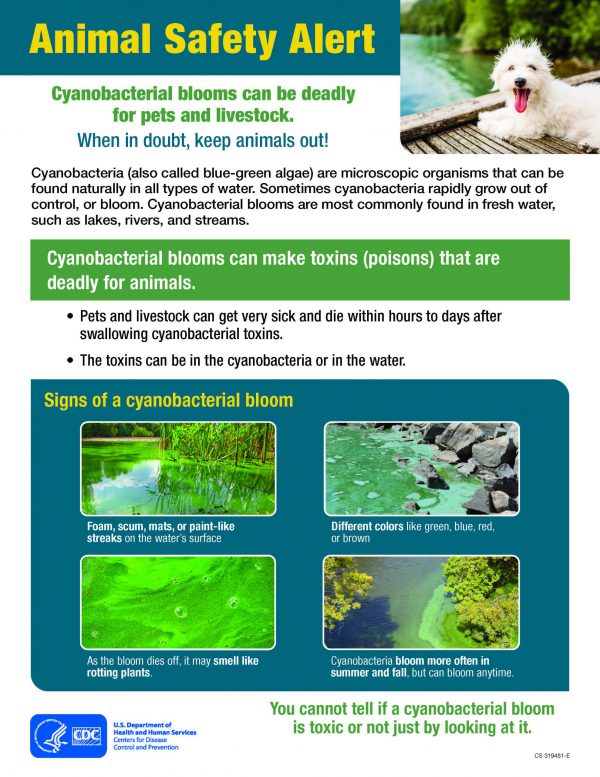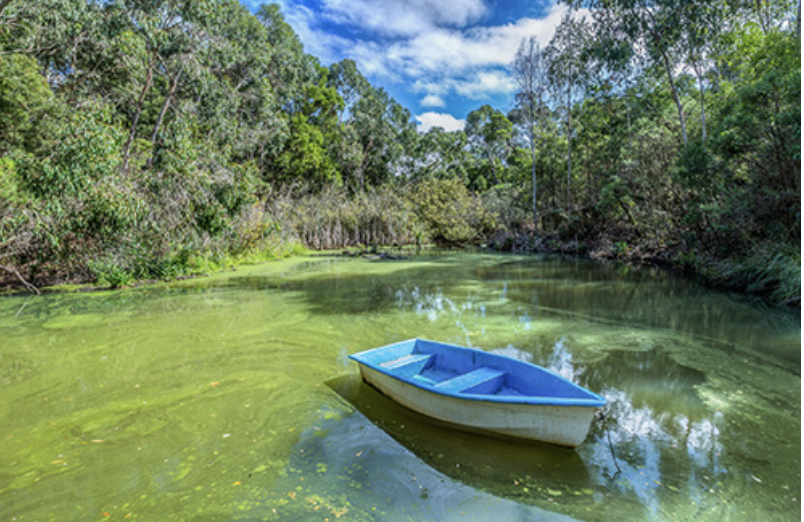Harmful algae and cyanobacteria, sometimes called blue-green algae, can produce toxins (poisons) that can make people and animals sick and affect the environment. Learn more about them to keep you, your family, and your pets safe.
Algae and cyanobacteria are simple, plant-like organisms that live in water. Algae and cyanobacteria can quickly grow out of control, or “bloom.”
Blooms can occur in fresh water, salt water, and brackish (a mixture of fresh and salt) water around the world. Blooms sometimes look like foam, scum, mats, or paint on the surface of the water. They can even make the water appear different colors, including green, blue, red, or brown.
Blooms are more likely when water is warm, slow-moving, and full of nutrients such as nitrogen or phosphorous. Nutrients get into water when fertilizer, sewage, or runoff from cities and industrial buildings washes into lakes, rivers, or oceans—for example, during rainstorms.
Blooms of algae or cyanobacteria can harm people, animals, or the environment if the blooms
- Make toxins
- Become too dense
- Use up the oxygen in the water
- Release harmful gases
Effects of climate change, such as warmer water, might be making blooms worse.
How People and Animals Get Sick

When in doubt, keep animals out! Download CDC’s Animal Safety Alert fact sheet for tips to protect your pets, or order free printed copies from CDC-INFO On Demand.
People and animals (including pets, livestock, and wildlife) can get sick when they have contact with water or food that contains certain types of algae, cyanobacteria, or their toxins.
People and animals can get sick if they
- Swim, wade, or play in or near contaminated water
- Eat contaminated fish, shellfish, or supplements
- Drink contaminated water
Illnesses and symptoms can vary depending on how a person or animal was exposed (came into contact with algae, cyanobacteria, or their toxins), how long they were exposed, which type of toxin was present, and how much toxin was present.
Symptoms in people can include
- Stomach pain, vomiting, or diarrhea
- Headache, fever, tiredness, or other general symptoms
- Skin, eye, nose, or throat irritation
- Neurological symptoms such as muscle weakness or dizziness
Exposure to some toxins—particularly cyanobacterial toxins—can also harm your liver and kidneys. If you think you may have symptoms caused by harmful algae, cyanobacteria, or their toxins, contact your healthcare provider or poison control center. Learn more about symptoms caused by algae, cyanobacteria, and their toxins.
Animals can get very sick or even die within minutes to days after exposure to harmful algae and cyanobacteria. Seek veterinary care immediately if your pets or livestock seem sick after going in or near water. Animals are often the first affected, in part because they are more likely to swim in or drink from bodies of water that contain harmful algae or cyanobacteria.

The One Health Harmful Algal Bloom System (OHHABS) collects information to help CDC and partners better understand and prevent illnesses caused by blooms of harmful algae and cyanobacteria.
When in Doubt, Stay Out
You can take steps to protect yourself and your pets from getting sick from harmful algae and cyanobacteria:
- Check for swimming and fishing advisories before visiting lakes, rivers, and oceans. Follow advisories to reduce your chances of getting sick.
- If you see a bloom, stay out of the water and keep your pets and livestock out of the water. You cannot tell if a bloom is harmful by looking at it, so it is best to use caution and stay away.
- Do not fish, swim, boat, or play water sports in areas where there are harmful algae or cyanobacteria.
- Do not go into water that
- Smells bad
- Looks discolored
- Has foam, scum, mats, or paint-like streaks on the surface
- Has dead fish or other animals washed up on its shore or beach
- If you are notified that harmful algae or cyanobacteria are in a nearby body of water or in your drinking water supply, follow local or state guidance to reduce your chances of getting sick.
- Check for and follow local shellfish and fish advisories before eating any fish or shellfish you collect.
Source: https://www.cdc.gov/habs/be-aware-habs.html



